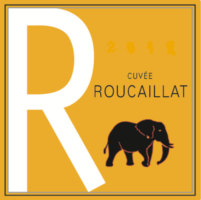GRIGRI
CUPIDONE
Table wine, blending Chasan, Chardonnay, and Clairette
This cuvée is produced using three grape varieties in proportions that vary from year to year:
- Chasan: this variety is the product of the hybridization of Chardonnay and Listan (an old local variety) in 1958, which was authorized to be planted in 1973. It is extremely drought-resistant and develops aromas similar to that of Chardonnay.
- Chardonnay: a variety having traveled far from its original terroirs.
- Clairette: a southern variety with a subtle, mineral flavor.
SAUVAGINE
AOC Coteaux du Languedoc White
This cuvée is a blend of two typically Mediterranean grape varieties:
- 75% White Grenache, which yields approximately 40 hl/ha – on this plot, the bedrock is dolomitic and is significantly visible on the surface, which greatly limits soil thickness. The yields are limited and consistent; 0.80 ha; planted in the early 1980’s;
- 25% Rolle (also called Vermentino), which has an approximate yield of 30 hl/ha – harvested from a plot just uphill from the previously mentioned one, which has slightly thicker soil, allowing for the planting of this variety; 0.50 ha; planted in the early 1980’s.
Its name is the word used to refer to small “garrigue” felines who help regulate the population of rabbits who are quite partial to young vines. Sauvagine designates the whole of these different small felines. This cuvée complements Roucaillat, because it has a more conventional organoleptic profile, with fresh flower, citrus, and very light spice aromas. It is produced from the first picking of Rolle that come in just before the one-time harvest of all of the Grenache.
ROUCAILLAT
AOC Coteaux du Languedoc White
This cuvée is a blend of three grape varieties:
- 1/6 White Grenache, with a yield of 40 hl/ha on a dolomitic substrate (same plot as that used for Sauvagine);
- 2/6 Rolle (also called Vermentino), with an approximate yield of 30 hl/ha. – harvested from a plot just uphill from the previously mentioned one, whose slightly thicker soil allowed for the planting of this variety.
- 3/6 Roussane. Here, Roussane provides yields around 25 hl/ha, spontaneously (without the use of corrective measures). It expresses a lovely mineral quality, accompanied by smoky aromas. It occupies the highest-altitude plot on the property (170 m).
Roucaillat is the flagship of our terroir. Approximately 14000 bottles are produced, yearly. A long maturation in the vat, as well as in the bottle give this wine a harmony that is able to express itself for numerous years. A “typically Mediterranean” white wine, its complex aromas and its structure make it the ideal complement to the unlikeliest of dishes. Several vintages are available.
ROCALHAN
The two grape varieties that combine to make this cuvée seem to be the best suited to this purpose, because, with the passage of time, a natural balance has been struck between yield (25-hl/ha) and vigor:
- Roussane: 2/3. Harvesting the plot in successive passes allows us to select grapes based on their maturity. Thus, the Roussane designated for this cuvée is harvested from the driest, highest part of the terroir. Its expression, therefore, depends greatly on the vintage, and certain years, the yield is to small to allow for the production of an individual cuvée.
- Rolle : 1/3. The grapes used here are also those harvested from the highest plot of that grape variety.
This is a very distinctive and concentrated wine, which pairs perfectly with a meal.

